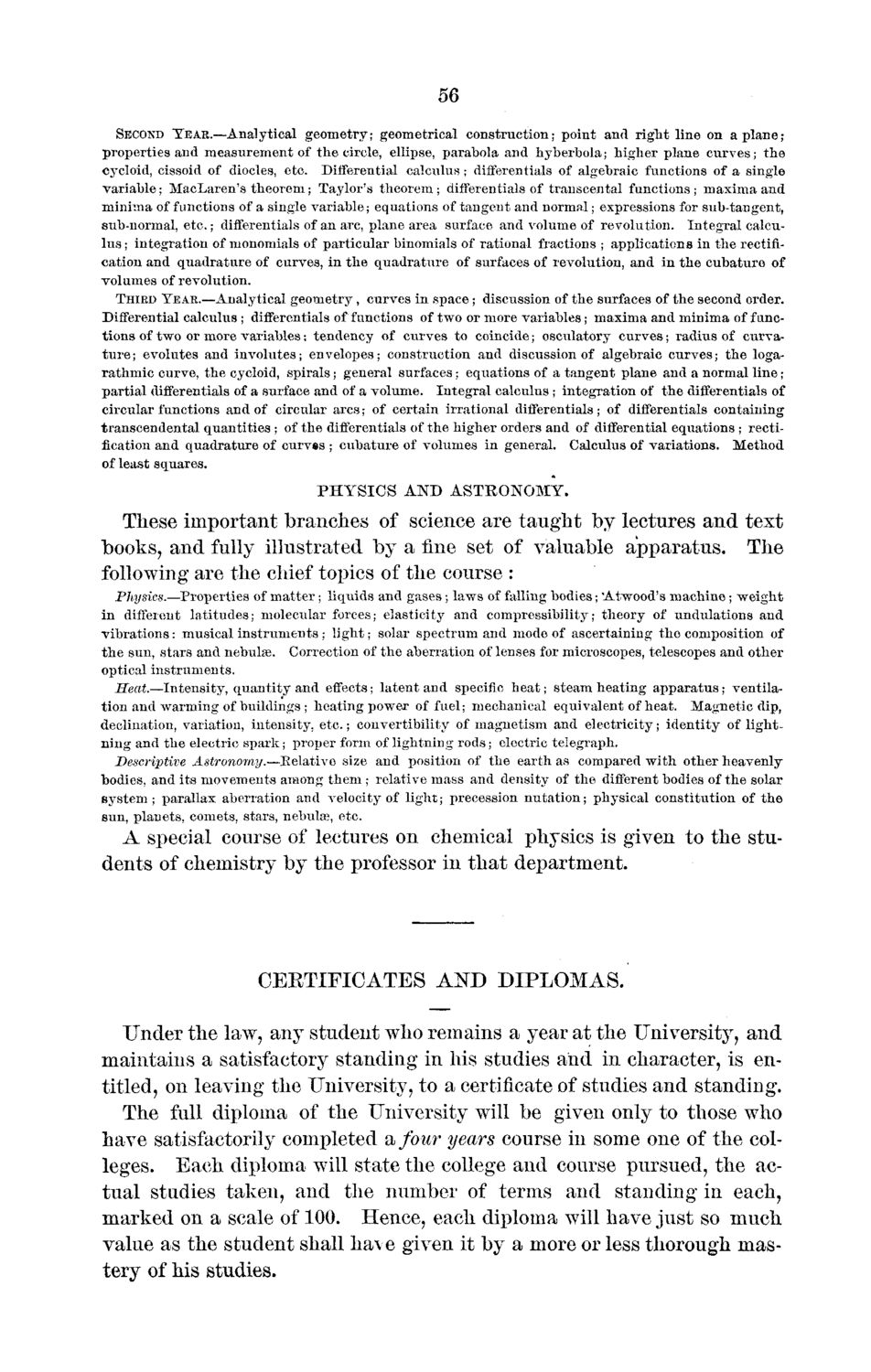| |
| |
Caption: Board of Trustees Minutes - 1872
This is a reduced-resolution page image for fast online browsing.

EXTRACTED TEXT FROM PAGE:
56 SECOND TEAR.—Analytical geometry; geometrical construction; point and right line on a plane; properties and measurement of the circle, ellipse, parabola and hyberbola; higher plane curves; the cycloid, cissoid of diocles, etc. Differential calculus; differentials of algebraic functions of a single variable; MacLaren's theorem; Taylor's theorem ; differentials of transcental functions ; maxima and minima of functions of a single variable; equations of tangent and normal; expressions for sub-tangent, sub-normal, etc.; differentials of an arc, plane area surface and volume of revolution. Integral calculus ; integration of monomials of particular binomials of rational fractions ; applications in the rectification and quadrature of curves, in the quadrature of surfaces of revolution, and in the cubature of volumes of revolution. THIRD TEAR.—Analytical geometry , curves in space; discussion of the surfaces of the second order. Differential calculus ; differentials of functions of two or more variables; maxima and minima of functions of two or more variables; tendency of curves to coincide; oscillatory curves; radius of curvature; evolutes and involutes; envelopes; construction and discussion of algebraic curves; the logarathmic curve, the cycloid, spirals; general surfaces; equations of a tangent plane and a normal line; partial differentials of a surface and of a volume. Integral calculus ; integration of the differentials of circular functions and of circular arcs; of certain irrational differentials; of differentials containing transcendental quantities ; of the differentials of the higher orders and of differential equations ; rectification and quadrature of curvss ; cubature of volumes in general. Calculus of variations. Method of least squares. PHYSICS AND ASTRONOMY. These important branches of science are taught by lectures and text books, and fully illustrated by a fine set of valuable apparatus. The following are the chief topics of the course : Physics.—Properties of matter; liquids and gases ; laws of falling bodies; Atwood's machine ; weight in different latitudes; molecular forces; elasticity and compressibility; theory of undulations and vibrations: musical instruments ; light; solar spectrum and mode of ascertaining the composition of the sun, stars and nebulas. Correction of the aberration of lenses for microscopes, telescopes and other optical instruments. Heat.—Intensity, quantity and effects; latent and specific heat; steam heating apparatus; ventilation and warming of buildings ; heating power of fuel; mechanical equivalent of heat. Magnetic dip, declination, variation, intensity, etc.; convertibility of magnetism and electricity; identity of lightning and the electric spark; proper form of lightning rods; electric telegraph. Descriptive Astronomy.—Eelative size and position of the earth as compared with other heavenly bodies, and its movements among them ; relative mass and density of the different bodies of the solar system ; parallax aberration and velocity of light; precession nutation; physical constitution of the sun, planets, comets, stars, nebulas, etc. A special course of lectures on chemical physics is given to the students of chemistry by the professor in that department. CEBTIFICATES A M ) DIPLOMAS. Under the law, any student who remains a year at the University, and maintains a satisfactory standing in his studies and in character, is entitled, on leaving the University, to a certificate of studies and standing. The full diploma of the University will be given only to those who have satisfactorily completed a, four years course in some one of the colleges. Each diploma will state the college and course pursued, the actual studies taken, and the number of terms and standing in each, marked on a scale of 100. Hence, each diploma will have just so much value as the student shall have given it by a more or less thorough mastery of his studies.
| |